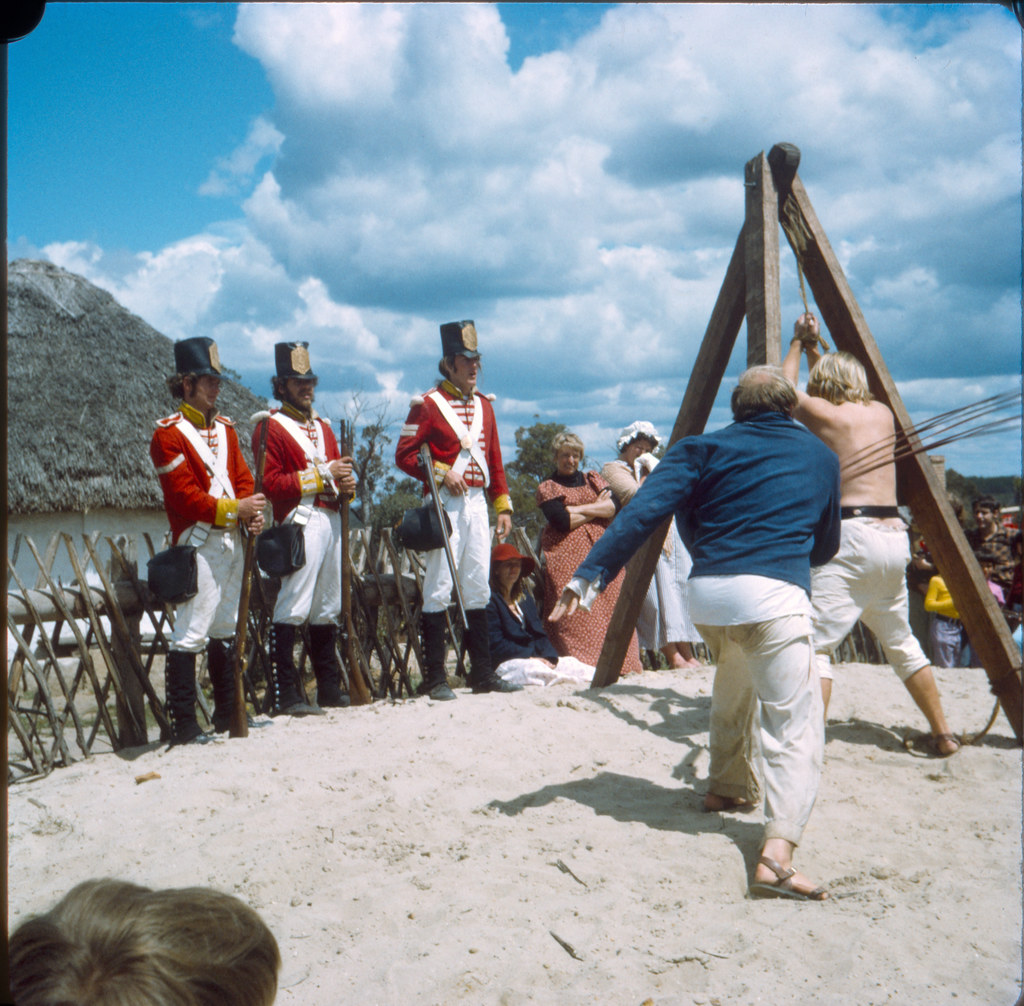IN 1975, A THEME park called Old Sydney Town outside Gosford in NSW was opened in the spirit of authenticity, recreationism, and heritage, and drew heavily on the example of Colonial Williamsburg in Virginia in the United States, in the sense that it was to be a living museum. Its organisers drew on academic expertise to get the very most knowledge, and to mimic as closely as possible the evolution of immediately post-contact Sydney. Professors of history were consulted and appointed, professional conservationists involved for their built environment expertise, antiquarians set to providing antiques, and traditionalist tradesmen hired as masons, carpenters, thatchers, limeburners, wood turners, plasterers, blacksmiths, potters, leatherworkers, ad infinitum. Soldier-reenactors were fitted for shakos, crossbelts and red jackets, gunsmiths supplied replica Brown Besses.
It goes without saying that there was no Aboriginal presence at Old Sydney Town.
What there were were buildings that were exceptionally painstakingly recreated using eighteenth-century techniques, tools, and work practices, in an elaborate pretend colony. Bullock drays carried tourists around, infantry soldiers in 1970s haircuts fired Napoleonic muskets, mock trials were held and mock corporal punishment was applied. It was a real attempt, a successful one, to embody in the present one specific story of the first two decades of colonial Australia. It was built at a time when these kinds of leisure parks were experiencing a high point in Australian life, consistent with Disneylands and theme parks in other places, and it declined when the technologism of the 1980s replaced them in popularity with other ways of experiencing family time and communal pasts. Its development (like the saying attributed to Hegel) is one of tragedy repeating itself as farce: while the undertaking in the 1970s was completely sincere and even high-minded, by the time it grew into its age in the 1990s, its reenactors played their roles in camp, Carry On Samuel Marsden, slyly self-referencing with winks, as if to assuage their own doubts about what they were doing. We remember Old Sydney Town now as high kitsch, and if kitsch is anything, it’s the ironic half-aware apology we make in shame for past sincerity.
In August this year, I spent $5 in an antiques shop on a box of Kodachrome slides marked ‘Old Sydney Town 1978’, and against all of my better instincts against the gauche and pretentious habit of ‘found photography’, ran them across my scanner. Kodachrome is a film, no longer produced, famous for its vivid colours, and these square slides, probably taken on an Instamatic camera, are testament to Paul Simon’s lyrics. This is a pure, excuse-less indulgement in second-hand nostalgia and voyeurism into someone else’s past, but it’s also an example of, as Interpretation Australia put it, ‘communicating ideas and feelings which help people understand more about themselves and their environment’. Looking at them, you get the immediate sensation of people understanding certain things about themselves and Australian history, and you have to be callous not to get a certain emotional response to the past of the past. But feelings don’t have to be based on truth, and who can really claim to inhabit a reality outside their own subjective emotions anyway? Consider the famous passage in Lowenthal’s The Past Is A Foreign Country (1985):
Re-enactments are patent anachronisms. But they do not always seem anachronistic; some actors become so involved in bygone events that they feel as though they are really living them. In making a film about the Napoleonic Wars those who portrayed officers and soldiers were paid at the same rate, but after a few days ‘the officers of this celluloid army began to eat at a separate table from the mere privates and NCOs’, …As a World War II Re-enactment Society ‘paratrooper’ put it, ‘You’ve got to be pretty stable not to get re-enacting and real life confused…’
Today, we are all re-enactors, and our sordid present will never match our sweet imagination. At the time of writing, the British seem to have elected a Conservative majority government; the twin election issues the question of Brexit and the future of austerity economics. It’s a common observation that the British seem to be poisoning themselves with nostalgia, with a faux Blitz spirit and a desire to relive the years of post-war Boom, to inhabit an Empire on which the sun did not in fact set and Spitfires forever battle Me109s over the Channel (even though the swastikas, these days, are more evenly geographically distributed). Owen Hatherley described the condition two years ago in Ministry of Nostalgia, around the nauseating repetition to Carry On, doing more with less, as if the British were capable in any sense of Keeping Calm about anything at all. Just as the other reactionary slogan to Make America Great Again is a specific revanchism of a glorious past that should have been and of wars that shouldn’t have been lost, we live in an era of fake graves, pretend soldiers, linen teatowels, Kodachrome vividity, and a perpetual interpretation of our desires of what should have been, through our feelings. Australian political nostalgia just wears a khaki uniform and slouch hat now, instead of a red coat.
Old Sydney Town might be zoned for redevelopment, but the concept lives in our politics.


